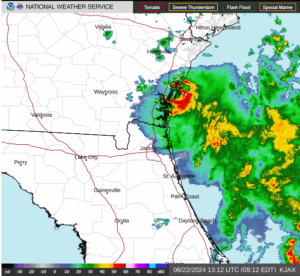Tropical Storm Alberto formed over the western Gulf of Mexico on Wednesday morning. At 11:00 a.m. EDT on Wednesday the center of Tropical Storm Alberto was located at latitude 22.2°N and longitude 95.0°W which put it about 185 miles (300 km) east of Tampico, Mexico and about 295 miles (480 km) south-southeast of Brownsville, Texas. Alberto was moving toward the west at 9 m.p.h. (15 km/h). The maximum sustained wind speed was 40 m.p.h. (65 km/h) and there were wind gusts to 50 m.p.h. (80 km/h). The minimum surface pressure was 995 mb.
A Tropical Storm Warning was in effect for the portion of the coast from San Luis Pass, Texas to Tecolutla, Mexico. The Tropical Storm Warning included Corpus Christi and Brownsville, Texas. The Tropical Storm Warning also included Tampico, Mexico.
More thunderstorms formed near the center of a low pressure system previously designated as Potential Tropical Cyclone One on Wednesday morning. A U.S. Air Force Reserve Hurricane Hunter reconnaissance aircraft was able to locate a well defined low level center of circulation and the U.S. National Hurricane Center designated the system as Tropical Storm Alberto.
The structure of Tropical Storm Alberto was beginning to resemble a typical tropical storm. Thunderstorms were forming near the center of Alberto’s circulation. A band of thunderstorms wrapped around the southern and eastern side of Tropical Storm Alberto. Other bands of showers and thunderstorms were revolving around the center of Alberto’s circulation. Storms near the center of Alberto began to generate upper level divergence that pumped mass away from the tropical storm. The removal of mass was causing the surface pressure to decrease.
Even though Tropical Storm Alberto was starting to look like a tropical storm, the distribution of winds was still asymmetrical. The circulation around the northern side of Alberto’s circulation was interacting with the southern part of a strong high pressure system over the eastern U.S. The interaction of the two pressure systems was causing the strongest winds to occur in the northern side of Tropical Storm Alberto. Winds to tropical storm force extended out 400 miles (645 km) north of the center of Alberto’s circulation. An anemometer at Garden Banks 783 (KGBK) measured a sustained wind speed of 45 m.p.h. (75 km/h) and wind gusts of 50 m.p.h (80 km/h). The anemometer is at a height of 58.2 meters above sea level. The winds in the southern part of Alberto’s circulation were blowing at less than tropical storm force.
Tropical Storm Alberto will move through an environment favorable for intensification during the next 12 hours. Alberto will move over water where the Sea Surface Temperatures are near 30°C. It will move under the the center of an upper level ridge over the western Gulf of Mexico. The upper level winds are weak near the center of the ridge and there will be little vertical wind shear. Tropical Storm Alberto will intensify during the next 12 hours. Alberto could undergo a brief period of rapid intensification when it approaches the coast of Mexico.
Tropical Storm Alberto will move south of a strong high pressure system over the eastern U.S. The high pressure system will steer Alberto toward the west during the next 24 hours. On its anticipated track, Tropical Storm Alberto will make landfall on the coast of northern Mexico on Wednesday night. The center of Alberto will make landfall near Tampico, Mexico.
Tropical Storm Alberto will produce gusty winds along the coast of Texas and northern Mexico. Alberto will also drop heavy rain on parts of northern Mexico and southern Texas. Up to 12 inches (300 mm) of rain could fall on parts of south Texas. Flood Watches were in effect for parts of South Central, Southeast and South Texas. Up to 20 inches (500 mm) of rain could fall on parts of northern Mexico where the winds blow the air up the slopes of mountains.
Easterly winds blowing around the northern side of Tropical Storm Alberto will blow the water toward the coast of Texas and northern Mexico. Alberto will cause a storm surge of up to six feet (two meters) where the winds blow the water toward the coast. Tropical Storm Alberto was already causing some flooding along parts of the coast of Texas. A tide station at San Luis Pass, Texas (LUIT2) was reporting a water level of 5.21 feet (1.59 meters). That water level is associated with Major Flooding. A tide station at Galveston Railroad Bridge (GRRT2) was reporting a water level of 4.77 feet (1.45 meters). That water level is associated with Major Flooding.

